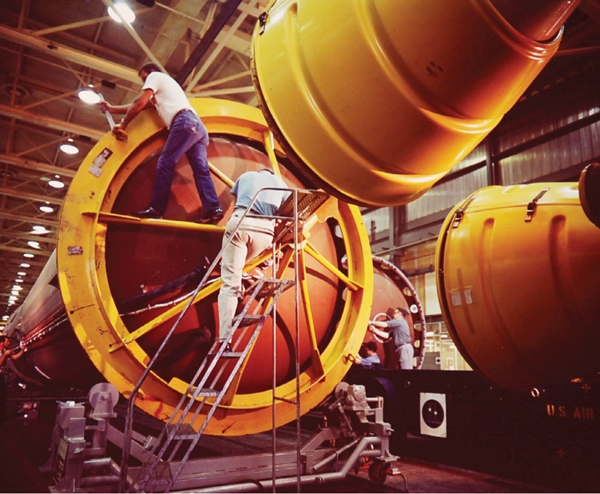
The earliest fictional account of a visit to the moon was written circa AD 170 by Lucian of Samosata. People no doubt had been dreaming of going to the moon for thousands of years before then. Approximately 1,700 years later, Jules Verne sparked the imagination of millions with his novel From the Earth to the Moon (1865). Though Verne was a Frenchman, his book told the story of an American effort to build a moon vehicle, with Florida as the locale of the launch site.
Heritage Images/Hulton Archive/Getty Images

In the high-tension atmosphere of the Cold War, Time magazine’s choice of Soviet premier Nikita Khrushchev as its 1957 Man of the Year proved unpopular with readers. The editors made a good case, though, for Krushchev’s dominance in “a year of retreat and disarray for the West.” The most stunning symbol of Soviet aspiration was Sputnik, the first man-made satellite. From Time, January 6, 1958 © Time Inc. Used under license.
From Time, January 6, 1958 © Time Inc. Used under license. TIME and Time Inc. are not affiliated with, and do not endorse products or services of, Licensee.

In 1958, scientists at the Jet Propulsion Laboratory in Pasadena, California, plotted the course of satellites by hand. Receiving tracking signals from earthbound stations, they triangulated them on a curved aluminum surface to chart progress.
John Bryson/The LIFE Images Collection/Getty Images

Project Mercury astronauts trying on space gear, including pressure suits, in 1959. Known as the Mercury Seven, all would go into space, eventually. Clockwise from left: unidentified technician, Donald “Deke” Slayton, John Glenn, Scott Carpenter, Leroy Gordon Cooper, Virgil “Gus” Grissom, Alan Shepard (in helmet), technician, Wally Schirra, technician.
Ralph Morse/The LIFE Picture Collection/Getty Images

Like the other Mercury astronauts, Gus Grissom (above) trained on a multiple-axis machine specially built to replicate and even exceed the amount of spinning actually encountered in space travel. The “gimbal rig” tumbled in all directions, testing the recruit’s capacity to function under such conditions as well as his ability to regain control of the machine.
Ralph Morse/The LIFE Picture Collection/Getty Images

The launch of the Freedom 7 mission at Cape Canaveral, Florida, on May 5, 1961, was viewed on television by forty-five million people. Alan Shepard, the sole occupant of the capsule, became the first American in space. That fact made his short flight, lasting only fifteen minutes, a watershed in the Cold War.
Bettmann/Getty Images

On February 23, 1962, President Kennedy visited Cape Canaveral to honor John Glenn, who three days earlier had become the first American to orbit the earth. He was photographed receiving a personal tour of Glenn’s Friendship 7 space capsule. Kennedy and Glenn would become warm friends, outside their towering roles in national events.
Universal Images Group/Getty Images

In June 1963, when NASA made the decision to end the Mercury program, the seven original astronauts, who had all been with the program since its inception in April 1959, were photographed together. From left to right: Gordon Cooper, Wally Schirra, Alan Shepard, Gus Grissom, John Glenn, Deke Slayton, and Scott Carpenter.
Courtesy of NASA

Engineers working through the night in 1963 at NASA’s assembly center near Edwards Air Force Base in Kern County, California.
Ralph Morse/The LIFE Picture Collection/Getty Images

Gordon Cooper, being strapped into the capsule Faith 7. On May 15, 1963, he piloted the final Mercury spaceflight, orbiting the Earth twenty-two times and staying in space for more than thirty-four hours.
Chris Howes/Wild Places Photography/Alamy Stock Photo

On September 11, 1962, President Kennedy attended a briefing at Cape Canaveral as part of a two-day whirlwind tour of space facilities throughout the South. The briefing was staged at the Launch Complex 34 blockhouse, a windowless control room that was large enough for 134 employees during a rocket launch. Seated with Kennedy are (left to right) NASA administrator James Webb, Lyndon Johnson, Launch Operations Center director Kurt Debus, an unidentified officer, and Secretary of Defense Robert McNamara.
Courtesy of NASA

On Saturday, November 16, 1963, President John F. Kennedy traveled to Cape Canaveral, where he met with German-born Dr. Wernher von Braun, the leading U.S. Army rocket engineer of the space era, to view the massive Saturn booster rocket, standing next to a model of one.
Interim Archives/Archives Photo/Getty Images

On July 16, 1969, almost six years after John F. Kennedy’s death, the thirty-fifth U.S. president’s dream of an American voyage to the moon came to fruition. Apollo 11 brought together the talents of many thousands of workers, but carried only three on the mission: Neil Armstrong, Buzz Aldrin, and Michael Collins. The Saturn V rocket, pictured above, propelled the Apollo 11 astronauts into space. Four days later, on July 20, Armstrong and Aldrin took the most daring step of all, climbing into the tiny Eagle lunar module and detatching from the command module, in which Collins remained. The spider-like Eagle then made its way to the surface of the moon.
Ralph Morse/The LIFE Picture Collection/Getty Images

“The Eagle has landed,” Neil Armstrong reported to Houston’s Apollo Mission Control on July 20, 1969. After six hours of further preparations and mandatory rest, Armstrong climbed down a ladder and set foot on the moon, saying, “That’s one small step for [a] man, one giant leap for mankind.” Armstrong later took this iconic photo of Buzz Aldrin posing with the American flag planted on the Sea of Tranquility. While Old Glory still stands on the moon, ultraviolet (UV) radiation has bleached the colors white.
NASA/Hulton Archive/Getty Images

After more than twenty-one hours on the moon, the Eagle successfully lifted off and approached the command module. The complex docking procedure was completed, reuniting the three astronauts for the journey home to Earth. Only after their safe arrival on July 24 could the Apollo 11 mission be fully celebrated as the epochal accomplishment that it was.
8383/Gamma-Rapho/Getty Images